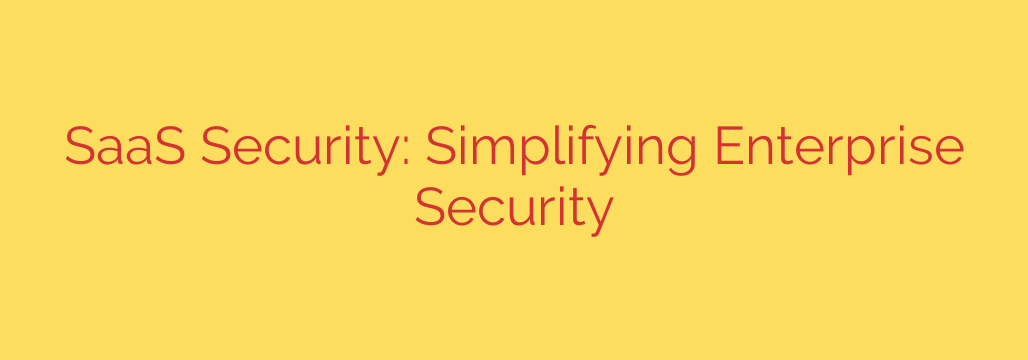
The Essential Guide to SaaS Security: Protecting Your Business in the Cloud
The way we work has fundamentally changed. Businesses today rely on a powerful ecosystem of Software-as-a-Service (SaaS) applications for everything from communication and collaboration (like Slack and Microsoft 365) to customer relationship management (Salesforce) and HR. While this shift to the cloud brings incredible flexibility and efficiency, it also introduces a new and complex set of security challenges.
Securing your on-premise servers is no longer enough. Protecting your enterprise now means securing the data, identities, and configurations scattered across dozens—or even hundreds—of third-party cloud applications. This guide breaks down the essential components of a modern SaaS security strategy to help you protect your most valuable assets.
Understanding the Shared Responsibility Model
The most critical concept in cloud security is the Shared Responsibility Model. In simple terms, it defines which security tasks are handled by the SaaS provider and which are your responsibility as the customer.
- The SaaS Provider’s Responsibility: The provider is responsible for securing the underlying infrastructure that runs the application. This includes their servers, networks, and physical data centers. They ensure the service itself is available and running securely.
- Your Responsibility: As the customer, you are responsible for securing how you use the service. This is the part many organizations overlook. Your responsibilities include managing user access, configuring security settings correctly, and protecting the data you store and share within the application.
Assuming the SaaS vendor handles all security is one of the biggest mistakes a company can make. The truth is, the most common and damaging security breaches in SaaS environments stem from customer-side misconfigurations and poor access management.
Top SaaS Security Risks You Cannot Ignore
To build a strong defense, you must first understand the threats. Here are the most prevalent security risks facing organizations that use SaaS applications.
1. Critical Security Misconfigurations
Every SaaS platform has a complex array of security settings that control everything from data sharing permissions to user privileges. A simple misconfiguration, like accidentally making a data repository public or granting excessive permissions to a user group, can instantly expose sensitive company information. Continuously auditing these settings across all your SaaS apps is non-negotiable.
2. Identity and Access Management (IAM) Challenges
Who has access to what? In a sprawling SaaS environment, this question becomes incredibly difficult to answer. Without centralized control, you face significant risks:
- Weak or reused passwords.
- Lack of Multi-Factor Authentication (MFA), leaving accounts vulnerable to compromise.
- “Permission creep,” where employees accumulate excessive access rights over time.
- Failure to de-provision accounts immediately when an employee leaves, creating “ghost accounts” that are prime targets for attackers.
3. The Rise of “Shadow IT”
Shadow IT refers to employees or departments using SaaS applications without official approval or oversight from the IT department. While often done with good intentions to improve productivity, unmanaged applications create massive security blind spots. These unsanctioned apps are not monitored, may not meet your company’s security standards, and can become a hidden gateway for data leakage.
4. Data Leakage and Exfiltration
SaaS applications are designed for easy collaboration and data sharing, which is also what makes them risky. Sensitive data—such as customer lists, financial reports, or intellectual property—can be inadvertently shared with the wrong people, or intentionally exfiltrated by a malicious insider or a compromised account.
5. Compliance and Regulatory Violations
If your organization handles regulated data (like PII, PHI, or financial information), you are subject to standards like GDPR, HIPAA, and PCI DSS. A misconfiguration or data leak within a SaaS application doesn’t just create a security incident; it can lead to a costly compliance violation, resulting in heavy fines and reputational damage.
Actionable Steps to Build a Robust SaaS Security Strategy
Protecting your enterprise requires a proactive and continuous approach. Here are the foundational steps for securing your SaaS ecosystem.
1. Gain Complete Visibility
You can’t protect what you can’t see. The first step is to discover every single SaaS application being used across your organization, including shadow IT. Use discovery tools to map out your entire SaaS footprint to understand where your data lives and who has access to it.
2. Enforce Strong and Centralized Access Controls
Implement a Zero Trust mindset by enforcing the Principle of Least Privilege, ensuring users only have the minimum access required to perform their jobs.
- Mandate Multi-Factor Authentication (MFA) across all applications that support it.
- Use a centralized Identity Provider (IdP) for Single Sign-On (SSO) to streamline user access and simplify on-boarding and off-boarding.
- Regularly review user permissions and revoke unnecessary access.
3. Automate Security with an SSPM Platform
Manually checking the configurations of hundreds of apps is impossible. A SaaS Security Posture Management (SSPM) tool is essential for modern security. These platforms connect to your SaaS applications via APIs and provide:
- Continuous monitoring for misconfigurations and security risks.
- Automated alerts for policy violations.
- Guided remediation steps to fix issues quickly.
- Compliance reporting to ensure you meet industry standards.
4. Educate Your Team
Your employees are your first line of defense. Conduct regular security awareness training that specifically addresses SaaS-related risks. Teach them how to spot phishing attempts, the importance of strong passwords, and the dangers of using unapproved applications for work-related data.
By taking these steps, you can move from a reactive security posture to a proactive one. Embracing SaaS applications is key to business growth, but it must be paired with a deliberate and robust security strategy. Protecting your data, identities, and configurations across your cloud environment is not just an IT task—it’s a fundamental business imperative.
Source: https://www.helpnetsecurity.com/2025/08/11/robert-buljevic-bridge-it-legacy-saas-security/








